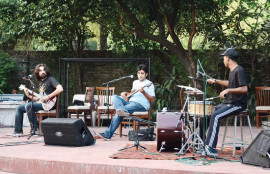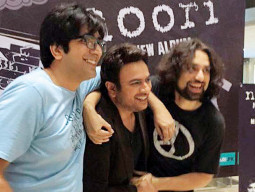
KARACHI:
The last time Noori was talking business about an album, Awais Lovely was still entertaining, Mathira was continually receiving prank calls on live TV and Justice Iftikhar Chaudhary was still being hailed as a hero. After more breakups and patch-ups than a high school couple, the band continued to remain afloat, sewing together bit by bit what would be the last of its trilogy of albums.
Seems fall is that time of the year for the brothers wherein the heart takes over the mind and creative leaps just happen. Suno Ke Main Hun Jawan came out on October 25 2003, Peeli Patti Aur Raja Jani Ki Gol Dunya on September 10, 2005 and Begum Gul Bakaoli Sarfarosh (BGBS) has been unveiled on October 9. In every sense, BGBS drives home the point that the element of nostalgia in Noori’s published works has a definite commercial value.
BGBS is a smart move in more ways than one. It craftily peddles with those who have the baggage of nostalgia from the previous two albums, haunting their judgment of the third. On the flipside, the generation that learnt about Noori’s existence only after the band’s Coke Studio stint, is given a taste of what exactly was missing in their lives.
Read: 8 reasons why you should listen to Noori's new album

The album’s promotional campaign itself translates what Ali Noor stated, “Fans holding our hearts in their hands.” No wonder the word dil (heart) appears 41 times across the nine tracks.
On one hand are Pakistani moms who do not allow drums in the house because the racket is unbearable and on the other there is Noor Zehra Kazim, helping her sons wrap 19 years of dreams in CD cases.
While we are still unsure about the generous mixing of electronic music with Noori’s formulae, BKBS toys with the genre adequately and does not leave room to protest. Aik Tha Badshah’s album version is clear of all the pretentious dubstep patterns and while the separately-released single hinted towards safe experimentation, the studio version is one for the old school aficionados who like their daal without chicken stock cubes.
Read: Noori’s labour of love finally shines through
We find the carefree Ali Hamza leading the line with vocals more often, with Noor’s harmony accentuating the feel defined by Hamza’s gruff vocal texture. Hey Ya stands as our pick from the album, a signature Noori track that stands true to its time. The crowd chants have although been overdone at places, reinforcing a point that no one questioned in the first place – Noori’s ability to set the stage on fire during live playing.
Mujhay Roko and 1947 have stayed with the band for a long time and their inclusion in the album was a debt Noori owed to its fans. While the former received not the best of treatment, 1947 has been drummed up to a whole new level.
Drumming up reminds us of Kami Paul. Gumby’s drum frenzies played a pivotal role in the formation of the Noori brand and Paul indeed had big boots to fill. Throughout the album, drums serve their purpose respectfully, not once getting ahead of any other component which might be a little irritating for some.
Read: More than music Prodigal sons return with new album
Hoshyar reveals the rather impressionable side of Noori that manifests itself in the garb of a Shankar Mahadevan song with helpings from popular progressive rock elements inherent to the 90s. Keedar, Sarfarosh and Pinjra are all reasonable and not as convincing as the other tracks. The album starts with 1947 and ends with Saya-e-Khuda-e-Zuljalal, a rendition of the national anthem that justifies the gradual development of BGBS’s ideological undercurrent.
When we say that Noori is more of an identity, we are strictly referring to the topos their published work invokes. The takrar (repetition) of minimal pairs of phonemes that are rooted in classical literary motifs helps the average listener connect with the band. While some may call that bland monotony, we’re just glad BGBS revels in the aforementioned method. With BGBS, Noori discovers itself and reclaims the college band identity that got lost in the 10 years of disillusionment.
Verdict: BGBS has something for most schools of thought. It creates the Noori brand anew, masterfully keeping the old world intact.
Rating:

Published in The Express Tribune, October 14th, 2015.
Like Life & Style on Facebook, follow @ETLifeandStyle on Twitter for the latest in fashion, gossip and entertainment.





























































COMMENTS
Comments are moderated and generally will be posted if they are on-topic and not abusive.
For more information, please see our Comments FAQ